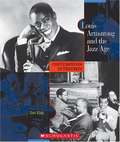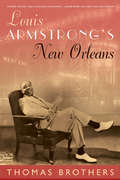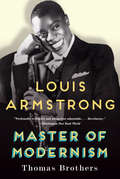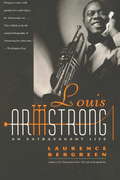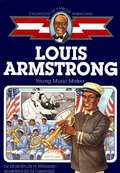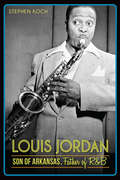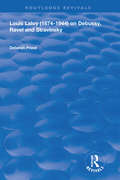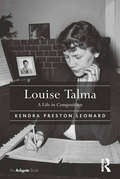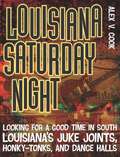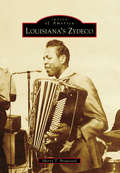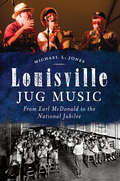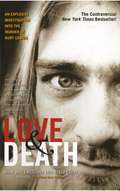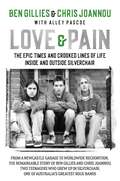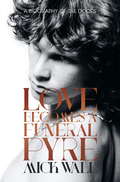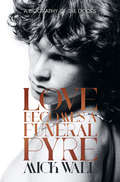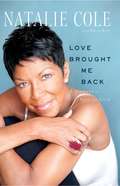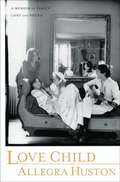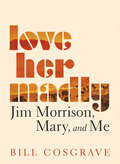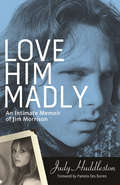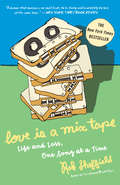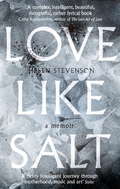- Table View
- List View
Louis Armstrong and the Jazz Age (Cornerstones of Freedom, 2nd Series)
by Dan ElishIn 1900, Louis Armstrong was born to a teenage mother in a depressed part of New Orleans. Jazz was born at around the same time. From the moment Louis began playing the trumpet as a young boy, "it was hypnosis at first hearing," said another young musician. Louis would go on to become one of the major driving forces behind the development of jazz, one of America's most important native-born art forms. Elish describes the emergence of the Jazz Age in American society and Armstrong's role in its success.
Louis Armstrong's Horn (Fountas & Pinnell Classroom, Guided Reading)
by J. C. Kane Charly PalmerNIMAC-sourced textbook. A LUCKY BREAK. Louis Armstrong was eleven years old when he was sent to live in a home for troubled boys. He thought it was the worst thing that had ever happened to him. But it turned out to be the best.
Louis Armstrong's New Orleans
by Thomas Brothers"The best book ever produced about Louis Armstrong by anyone other than the man himself."--Terry Teachout, Commentary In the early twentieth century, New Orleans was a place of colliding identities and histories, and Louis Armstrong was a gifted young man of psychological nimbleness. A dark-skinned, impoverished child, he grew up under low expectations, Jim Crow legislation, and vigilante terrorism. Yet he also grew up at the center of African American vernacular traditions from the Deep South, learning the ecstatic music of the Sanctified Church, blues played by street musicians, and the plantation tradition of ragging a tune. Louis Armstrong's New Orleans interweaves a searching account of early twentieth-century New Orleans with a narrative of the first twenty-one years of Armstrong's life. Drawing on a stunning body of first-person accounts, this book tells the rags-to-riches tale of Armstrong's early life and the social and musical forces that shaped him. The city and the musician are both extraordinary, their relationship unique, and their impact on American culture incalculable. Some images in this ebook are not displayed owing to permissions issues.
Louis Armstrong, Master of Modernism
by Thomas BrothersFinalist for the 2015 Pulitzer Prize in Biography. "Profoundly evocative and altogether admirable...The writing and detail are so brilliant that I found the volume revelatory." --Tim Page, Washington Post Nearly 100 years after bursting onto Chicago's music scene under the tutelage of Joe "King" Oliver, Louis Armstrong is recognized as one of the most influential artists of the twentieth century. A trumpet virtuoso, seductive crooner, and consummate entertainer, Armstrong laid the foundation for the future of jazz with his stylistic innovations, but his story would be incomplete without examining how he struggled in a society seething with brutally racist ideologies, laws, and practices. Thomas Brothers picks up where he left off with the acclaimed Louis Armstrong's New Orleans, following the story of the great jazz musician into his most creatively fertile years in the 1920s and early 1930s, when Armstrong created not one but two modern musical styles. Brothers wields his own tremendous skill in making the connections between history and music accessible to everyone as Armstrong shucks and jives across the page. Through Brothers's expert ears and eyes we meet an Armstrong whose quickness and sureness, so evident in his performances, served him well in his encounters with racism while his music soared across the airwaves into homes all over America. Louis Armstrong, Master of Modernism blends cultural history, musical scholarship, and personal accounts from Armstrong's contemporaries to reveal his enduring contributions to jazz and popular music at a time when he and his bandmates couldn't count on food or even a friendly face on their travels across the country. Thomas Brothers combines an intimate knowledge of Armstrong's life with the boldness to examine his place in such a racially charged landscape. In vivid prose and with vibrant photographs, Brothers illuminates the life and work of the man many consider to be the greatest American musician of the twentieth century.
Louis Armstrong: An American Genius
by James Lincoln CollierLouis Armstrong. "Satchmo." To millions of fans, he was just a great entertainer. But to jazz aficionados, he was one of the most important musicians of our times--not only a key figure in the history of jazz but a formative influence on all of 20th-century popular music. Set against the backdrop of New Orleans, Chicago, and New York during the "jazz age", Collier re-creates the saga of an old-fashioned black man making it in a white world. He chronicles Armstrong's rise as a musician, his scrapes with the law, his relationships with four wives, and his frequent feuds with fellow musicians Earl Hines and Zutty Singleton. He also sheds new light on Armstrong's endless need for approval, his streak of jealousy, and perhaps most important, what some consider his betrayal of his gift as he opted for commercial success and stardom. A unique biography, knowledgeable, insightful, and packed with information, it ends with Armstrong's death in 1971 as one of the best-known figures in American entertainment.
Louis Armstrong: An Extravagant Life
by Laurence BergreenLouis Armstrong was the founding father of jazz and one of this century's towering cultural figures, yet the full story of his extravagant life has never been told.Born in 1901 to the sixteen-year-old daughter of a slave, he came of age among the prostitutes, pimps, and rag-and-bone merchants of New Orleans. He married four times and enjoyed countless romantic involvements in and around his marriages. A believer in marijuana for the head and laxatives for the bowels, he was also a prolific diarist and correspondent, a devoted friend to celebrities from Bing Crosby to Ella Fitzgerald, a perceptive social observer, and, in his later years, an international goodwill ambassador.And, of course, he was a dazzling musician. From the bordellos and honky-tonks of Storyville--New Orleans's red light district--to the upscale nightclubs in Chicago, New York, and Hollywood, Armstrong's stunning playing, gravelly voice, and irrepressible personality captivated audiences and critics alike. Recognized and beloved wherever he went, he nonetheless managed to remain vigorously himself.Now Laurence Bergreen's remarkable book brings to life the passionate, courageous, and charismatic figure who forever changed the face of American music.
Louis Armstrong: Young Music Maker (Childhood of Famous Americans Series)
by Dharathula H. MillenderA fictionalized biography of a trumpeter of humble origin who received international acclaim as a jazz entertainer.
Louis Jordan: Son of Arkansas, Father of R&B (Music Ser.)
by Stephen KochThough you may not know the man, you probably know his music. Arkansas-born Louis Jordan's songs like "Baby, It's Cold Outside," "Caldonia" and "Ain't Nobody Here But Us Chickens" can still be heard today, decades since Jordan ruled the charts. In his five-decade career, Jordan influenced American popular music, film and more and inspired the likes of James Brown, B.B. King, Chuck Berry and Ray Charles. Known as the "King of the Jukeboxes," he and his combo played a hybrid of jazz, swing, blues and comedy music during the big band era that became the start of R&B. In a stunning narrative portrait of Louis Jordan, author Stephen Koch contextualizes the great, forgotten musician among his musical peers, those he influenced and the musical present.
Louis Laloy (Routledge Revivals)
by Deborah PriestFirst published in 1999, this is the first study of the noted French music critic and scholar Louis Laloy, and the first collection of his writings. His writings were unique in their time and have never previously been translated. Laloy’s ideas on Debussy, Ravel and Stravinsky are presented here with an introduction by Deborah Priest to each extract, placing it in the context of the period and the composer’s work. Detailed annotations explain technical and cultural references. As a friend of all three composers, but especially of Debussy, Laloy wrote with great authority and influence: his work provides recollections, analytical insights, and insights into reception and performance practice. His erudition and wide range of reference make for fascinating and enlightening reading about the period. Deborah Priest provides a detailed introduction which sets Laloy’s work against the background of the Paris music scene from 1900- 1940.
Louise Talma: A Life in Composition (Cms Monographs And Sourcebooks In American Music Ser.)
by Kendra Preston LeonardAmerican composer Louise Talma (1906-1996) was the first female winner of two back-to-back Guggenheim Awards (1946, 1947), the first American woman to have an opera premiered in Europe (1962), the first female winner of the Sibelius Award for Composition (1963), and the first woman composer elected to the American Academy and Institute of Arts and Letters (1974). This book analyses Talma’s works in the context of her life, focusing on the effects on her work of two major changes she made during her adult life: her conversion to Catholicism as an adult, under the guidance of Nadia Boulanger, and her adoption of serial compositional techniques. Employing approaches from traditional musical analysis, feminist and queer musicology, and women’s autobiographical theory to examine Talma’s body of works, comprising some eighty pieces, this is the first full-length study of this pioneering composer. Exploring Talma’s compositional language, text-setting practices, and the incorporation of autobiographical elements into her works using her own letters, sketches, and scores, as well as a number of other relevant documents, this book positions Talma’s contributions to serial and atonal music in the United States, considers her role as a woman composer during the twentieth century, and evaluates the legacy of her works and career in American music.
Louisiana Saturday Night: Looking for a Good Time in South Louisiana's Juke Joints, Honky-Tonks, and Dance Halls (Southern Messenger Poets)
by Alex V. CookFrom backwoods bars and small-town dives to swampside dance halls and converted clapboard barns, Louisiana Saturday Night offers an anecdotal history and experiential guidebook to some of the Gumbo State's most unique blues, Cajun, and zydeco clubs. Music critic Alex V. Cook uncovers south Louisiana's wellspring of musical tradition, showing us that indigenous music exists not as an artifact to be salvaged by preservationists, but serves as a living, breathing, singing, laughing, and crying part of Louisiana culture. Louisiana Saturday Night takes the reader to both offbeat and traditional venues in and around Baton Rouge, Cajun country, and New Orleans, where we hear the distinctive voices of musicians, patrons, and owners -- like Teddy Johnson, born in the house that now serves as Teddy's Juke Joint. Along the way, Cook ruminates on the cultural importance of the people and places he encounters, and shows their critical role in keeping Louisiana's unique music alive. A map, a journal, a snapshot of what goes on in the little shacks off main roads, Louisiana Saturday Night provides an indispensable and entertaining companion for those in pursuit of Louisiana's quirky and varied nightlife.
Louisiana's Zydeco
by Sherry T. BroussardThe bayou sings and the trees sway with the untold stories of many unsung heroes, including Louisiana's amazing Zydeco musicians. The music is an extraordinary blend of the accordion, the bass and electric guitars, the drums, the rub or scrub board, and other instruments. It tells stories about finding and losing love, life lessons, and other revelatory events that rise from the skillful hands of musicians playing the diatonic and piano accordions. The diverse population of Louisiana creates a rich culture with Zydeco festivals, Creole foods, and the unique music that fills the air with a foot-stomping beat like no other. Louisiana's Zydeco is a snapshot of some of the many musicians who live and play the homegrown music known as Zydeco.
Louisville Jug Music: From Earl McDonald to the National Jubilee (Music Ser.)
by Michael L. JonesForged on the Ohio and Mississippi Rivers during the nineteenth century, jug band music was the early soundtrack for a new nation. Louisville was at the heart of it all. German and Irish immigrants, former slaves en route to Chicago and homesteaders moving into the city created a fertile ground for this new sound. Artists like Earl McDonald and his Original Louisville Jug Band made the city legendary. Some stayed in this so-called money town, passing on licks and melodies that still influence bands like the Juggernaut Jug Band. Tune in to Louisville's jug band music history with local writer Michael Jones and discover a tradition that has left a long-lasting impression on America's musical culture.
Love & Death: The Murder of Kurt Cobain
by Ian Halperin Max WallaceA stunning and groundbreaking investigation into the death of one of the great rock icons of our times -- revealing new evidence that points to a terrible conclusion. On Friday, April 8, 1994, a body was discovered in a room above a garage in Seattle. For the attending authorities, it was an open-and-shut case of suicide. What no one knew then, however, and which is only being revealed here for the very first time, is that the person found dead that day -- Kurt Cobain, the superstar frontman of Nirvana -- was murdered. In early April 1994, Cobain went missing for days, or so it seemed; in fact, some people knew where he was, and one of them was Courtney Love. Now a star in Hollywood and rock music, in early 1994 she was preparing to release her major label debut with her band, Hole, and what she knew then, though few others did, was that Cobain was planning to divorce her. Love & Death paints a critical portrait of Courtney Love; it also reveals for the first time the case tapes made by Love's own P.I., Tom Grant, a man on a mission to find the truth about Kurt Cobain's demise; and introduces us to a number of characters who feature in various theories about plots to kill Cobain. In addition, Cobain's grandfather goes public, charging that his grandson was murdered. Drawing on new forensic evidence and police reports obtained under the Freedom of Information Act, the book explodes the myths that have long convinced the world that Cobain took his own life, and reveals that the official scenario was scientifically impossible. Against a background of at least sixty-eight copycat suicides since 1994, award-winning investigative journalists Max Wallace and Ian Halperin have conducted a ten-year crusade for the truth, and in Love & Death they are finally able to present a chilling and convincing case that each and every one of these suicides was preventable -- and in doing so, they call for this case to be reopened and properly investigated.
Love & Pain: The epic times and crooked lines of life inside and outside Silverchair
by Ben Gillies Chris JoannouThis is the powerful, untold story of two of the three members of Silverchair, Australia's most awarded musical act. From their beginnings in Ben Gillies' garage, this trio of high school kids from Newcastle, New South Wales, became famous with their smash-hit single 'Tomorrow', setting them on a path to domination of the Australian charts, worldwide touring and fame.So much has been written about Silverchair over the years but very little has been said by the band's members. In Love & Pain, childhood friends Ben Gillies (drummer) and Chris Joannou (bass player) tell us tales about growing up across the road from each other and starting in Silverchair, wild stories from the peak of their days in the spotlight, and the ups and downs of how their lives have panned out since.While there are some funny, unforgettable rock 'n' roll stories, there is also all the love and pain that came with being in the band: the cost of fame and intense pressure on two teenagers who had no way of preparing for it; the navigation of their friendships with each other and their relationships with friends and family members; the mistakes they made and the successes they cherished. Gillies and Joannou write with vulnerability and raw and blistering honesty, making for an extraordinary account of a band adored by so many.
Love Becomes a Funeral Pyre: A Biography of The Doors
by Mick Wall'Explodes in to life from the opening paragraph' RECORD COLLECTORThink you know the story of Jim Morrison and The Doors? This revelatory and explosive biography from critically acclaimed rock journalist Mick Wall will make you think again.'The pick of the best guitar tomes: Wall's account pulls no punches, cataloguing each of the primal scenes - early performances, indecent exposure, Jim's sexuality, decline and death' GUITARISTIn 1971, Jim Morrison was found dead in a club toilet in Paris. He was 27 years old. Since then, The Doors have been the subject of a mystery fuelled by sensationalised rumours and empty conjecture.In this definitive account of Jim Morrison and The Doors, critically acclaimed rock writer Mick Wall unravels the myths surrounding the iconic band and its frontman, and captures the unique and unforgettable spirit of the sixties. A brilliantly penetrating and long-overdue biography, Love Becomes a Funeral Pyre questions the idolisation of Jim Morrison and considers the story of The Doors in all of its uncomfortable truth.
Love Becomes a Funeral Pyre: A Biography of The Doors
by Mick Wall'Explodes in to life from the opening paragraph' RECORD COLLECTORThink you know the story of Jim Morrison and The Doors? This revelatory and explosive biography from critically acclaimed rock journalist Mick Wall will make you think again.'The pick of the best guitar tomes: Wall's account pulls no punches, cataloguing each of the primal scenes - early performances, indecent exposure, Jim's sexuality, decline and death' GUITARISTIn 1971, Jim Morrison was found dead in a club toilet in Paris. He was 27 years old. Since then, The Doors have been the subject of a mystery fuelled by sensationalised rumours and empty conjecture.In this definitive account of Jim Morrison and The Doors, critically acclaimed rock writer Mick Wall unravels the myths surrounding the iconic band and its frontman, and captures the unique and unforgettable spirit of the sixties. A brilliantly penetrating and long-overdue biography, Love Becomes a Funeral Pyre questions the idolisation of Jim Morrison and considers the story of The Doors in all of its uncomfortable truth.
Love Becomes a Funeral Pyre: A Biography of the Doors
by Mick WallFrom one of rock's greatest writers, Love Becomes a Funeral Pyre is the definitive biography of the Doors Spanning the entire history of the band, from the birth of its members to the deaths of those who have departed, this book will long remain the definitive history of a band that changed the history of popular music. The band that started out as the "American Rolling Stones," noted for their wildly unpredictable performances, their jazzy vibe, and the crazed monologues of their front man, ended as badly as did the '60s: abruptly, bloodily, cripplingly. Along with evoking the cultural milieu of Los Angeles in the era, bestselling writer Mick Wall captures the true spirit of that tarnished age. From the release of their classic first album, The Doors, to their last with Jim Morrison, L.A. Woman, this band biography is a brilliantly penetrating and contemporary investigation into the real story of the Doors.
Love Brought Me Back: A Journey of Loss and Gain
by David Ritz Natalie ColeIN THIS LUMINOUS MEMOIR, LEGENDARY SINGER AND ACTRESS NATALIE COLE TELLS A REMARKABLE STORY OF LIFE-THREATENING ILLNESS AND RECOVERY, AND THE STORY OF A DEATH THAT BROUGHT NEW LIFE. In 2009 Natalie Cole was on dialysis, her kidneys failing. Without a kidney transplant, her future was uncertain. Throughout Natalie's illness one of her biggest supporters was her beloved sister Cooke. But then Cooke herself became ill, with cancer. Astonishingly, as Cooke lay dying in a hospital, Natalie received a call that a kidney was available, but the surgery had to be performed immediately. Natalie couldn't leave her sister's side--but neither could she refuse the kidney that would save her own life. This is a story of sisters, Natalie and Cooke, but also of the sisters who made the transplant possible, Patty and Jessica. It was Jessica's death that gave new life to Natalie, even as Natalie experienced the devastating loss of Cooke. Patty, too, suffered her own terrible loss, but when she met Natalie, she found that her sister's spirit still lived. Through the gift of life, Natalie and Patty became sisters in spirit. Love Brought Me Back is a story of loss and recovery, sorrow and joy, success and despair--and, finally, success again. It will touch you as few memoirs ever have.
Love Child: A Memoir of Family Lost and Found
by Allegra HustonWhen Allegra Huston was four years old, her mother was killed in a car crash. Soon afterward, she was introduced to an intimidating man wreathed in cigar smoke -- the legendary film director John Huston -- with the words, "This is your father." So began an extraordinary odyssey: from the magical Huston estate in Ireland to the Long Island suburbs to a hidden paradise in Mexico -- and, at the side of her older sister, Anjelica, into the hilltop retreats of Jack Nicholson, Ryan O'Neal, and Marlon Brando. Allegra's is the penetrating gaze of an outsider never quite sure if she belongs in this rarefied world and of a motherless child trying to make sense of her famous, fragmented family.
Love Her Madly: Jim Morrison, Mary, and Me
by Bill CosgraveA riveting memoir that works its magic like a slow-acting drug, revealing the story of Jim Morrison’s first love, a long-lost friendship, and the man who existed before the Doors. In the spring of 1965, Bill Cosgrave was smuggled across the border into the United States after receiving an irresistible invitation from his captivating friend Mary Werbelow. When he made it to her apartment in Los Angeles, Mary introduced Bill to her boyfriend, Jim Morrison. The two young men quickly bonded. When Jim and Mary’s relationship faltered, Jim headed for Venice beach with his notebook. Bill and Jim spent endless days together, enjoying the aimlessness of their youth and the freedom of the times, fuelled by Jim's unlimited supply of dope. Jim’s writing would morph into iconic hit songs, rocketing him to international fame as the hypnotic lead singer of the Doors. Beautiful Mary would set off on her own journey. After years of futile searching, Bill finally tracks down the woman he had secretly loved. He’s dying to know where her life has taken her and stunned by what he discovers.
Love Him Madly: An Intimate Memoir of Jim Morrison
by Pamela Des Barres Judy HuddlestonChronicling a young woman's four-year relationship with the lead singer of the Doors, this intensely intimate memoir provides a direct and unprecedented view of the late-1960s Los Angeles subculture. When Judy Huddleston's parents got divorced, she spent her last year of high school attending concerts. Transformed from a perceptive child into a rebellious teenager bent on attracting boys and fueled by psychedelics, she had lost her sense of self. That's when Jim Morrison came into her life. Honest, funny and direct, Huddleston provides an emotional portrayal of an unbalanced sexual relationship with a man whose demons haunted everyone he knew, while offering an even-handed portrait of Jim as a complex human being. Written in the idealistic and simultaneously jaded voice of a teenager, this is a tale of sex, obsession, misplaced spirituality, and an unforgettable fall from innocence.
Love Is a Mix Tape: Life, Loss, and What I Listened To
by Rob Sheffield&“The happiest, saddest, sweetest book about rock &‘n&’ roll that I&’ve ever experienced.&”—Chuck Klosterman Mix tapes: We all have our favorites. Stick one into a deck, press play, and you&’re instantly transported to another time in your life. For Rob Sheffield, that time was one of miraculous love and unbearable grief. A time that spanned seven years, it started when he met the girl of his dreams, and ended when he watched her die in his arms. Using the listings of fifteen of his favorite mix tapes, Rob shows that the power of music to build a bridge between people is stronger than death. You&’ll read these words, perhaps surprisingly, with joy in your heart and a song in your head—the one that comes to mind when you think of the love of your life. Praise for Love is a Mixtape &“A memoir that manages, no small feat, to be funny and beautifully forlorn at the same time.&”—The New York Times Book Review &“Humorous, heartbreaking, and heroic.&”—Entertainment Weekly &“The finest lines ever written about rock &‘n&’ roll . . . Like that song on the radio, every word of Rob&’s book is true. Love is a mix tape.&”—Rolling Stone &“Many of us use pop culture as a mirror of our emotional lives, but Sheffield happily walks right through the looking glass.&”—Los Angeles Times &“Sheffield writes with such aching remembering, you feel like you are invading his privacy . . . and it&’s the truth of those details that make this memoir so touching.&”—Newsweek
Love Like Salt: A Memoir
by Helen StevensonCHOSEN BY MAGGIE O'FARRELL IN THE GUARDIAN AS ONE OF HER BEST BOOKS OF THE YEAR'It's a slice of a life . . . a complex, intelligent, beautiful, thoughtful, rather lyrical book' -Cathy Rentzenbrink, author of The Last Act of Love'A moving treatise on inheritance, not just of a disease like cystic fibrosis, but of our attitudes to living and loving, our sense of cultural and familial landscape, and how these intangibles pass down through generations. Stevenson picks apart her life like a strand of DNA to uncover just how we become the sum of our parts' Daily Telegraph'A beautiful memoir . . . [Stevenson] is a novelist and a translator and her memoir is about translation in the larger sense. Translating the world is what we all do but she reminds us that one can hope - with a mind as intricately well read and original as hers - to translate misfortune; to absorb and see beyond it . . . Stevenson makes of poetry, fiction and philosophy a protective shawl for her story . . . Although intense she has a carefree wit' Kate Kellaway, Observer'Love Like Salt is a human triumph ... Ultimately, Love Like Salt follows in the hallowed footsteps of Helen MacDonald's brilliant H is for Hawk or Cathy Rentzenbrink's The Last Act of Love. These are not misery memoirs but reminders that life comes in all shades - that in the darkest moments, beauty and humour can be found' Francesca Brown, Stylist'Did Clara taste salty when I kissed her? She did. She tasted of mermaids, of the sea.'Love Like Salt is a deeply affecting memoir, beautifully and intelligently written. It is about mothers and daughters, music and illness, genes and inheritance, writing and story-telling. It is about creating joy from the hand you've been dealt and following its lead - in this case to rural France, where the author and her family lived for seven years. And back again.'I had always written, and until the birth of Clara I wrote for a living. Once I knew the Cystic Fibrosis gene had unfolded itself in our daughter's body, like a paper flower meeting water, I felt that to write, even if I had had time, or been able, would have been to squander a kind of power which was needed for tending and nurturing. Every moment became a moment in which I protected my baby. Some of it I did in secret, like a madwoman muttering spells. I thought of her as a candle, cupping my hand around her.A beautifully written memoir, in the vein of H is for Hawk and The Last Act of Love, about motherhood, music and living the best life you can, even in the shadow of illness.
Love Like Salt: A Memoir
by Helen StevensonCHOSEN BY MAGGIE O'FARRELL IN THE GUARDIAN AS ONE OF HER BEST BOOKS OF THE YEAR'It's a slice of a life . . . a complex, intelligent, beautiful, thoughtful, rather lyrical book' -Cathy Rentzenbrink, author of The Last Act of Love'A moving treatise on inheritance, not just of a disease like cystic fibrosis, but of our attitudes to living and loving, our sense of cultural and familial landscape, and how these intangibles pass down through generations. Stevenson picks apart her life like a strand of DNA to uncover just how we become the sum of our parts' Daily Telegraph'A beautiful memoir . . . [Stevenson] is a novelist and a translator and her memoir is about translation in the larger sense. Translating the world is what we all do but she reminds us that one can hope - with a mind as intricately well read and original as hers - to translate misfortune; to absorb and see beyond it . . . Stevenson makes of poetry, fiction and philosophy a protective shawl for her story . . . Although intense she has a carefree wit' Kate Kellaway, Observer'Love Like Salt is a human triumph ... Ultimately, Love Like Salt follows in the hallowed footsteps of Helen MacDonald's brilliant H is for Hawk or Cathy Rentzenbrink's The Last Act of Love. These are not misery memoirs but reminders that life comes in all shades - that in the darkest moments, beauty and humour can be found' Francesca Brown, Stylist'Did Clara taste salty when I kissed her? She did. She tasted of mermaids, of the sea.'Love Like Salt is a deeply affecting memoir, beautifully and intelligently written. It is about mothers and daughters, music and illness, genes and inheritance, writing and story-telling. It is about creating joy from the hand you've been dealt and following its lead - in this case to rural France, where the author and her family lived for seven years. And back again.'I had always written, and until the birth of Clara I wrote for a living. Once I knew the Cystic Fibrosis gene had unfolded itself in our daughter's body, like a paper flower meeting water, I felt that to write, even if I had had time, or been able, would have been to squander a kind of power which was needed for tending and nurturing. Every moment became a moment in which I protected my baby. Some of it I did in secret, like a madwoman muttering spells. I thought of her as a candle, cupping my hand around her.A beautifully written memoir, in the vein of H is for Hawk and The Last Act of Love, about motherhood, music and living the best life you can, even in the shadow of illness.
